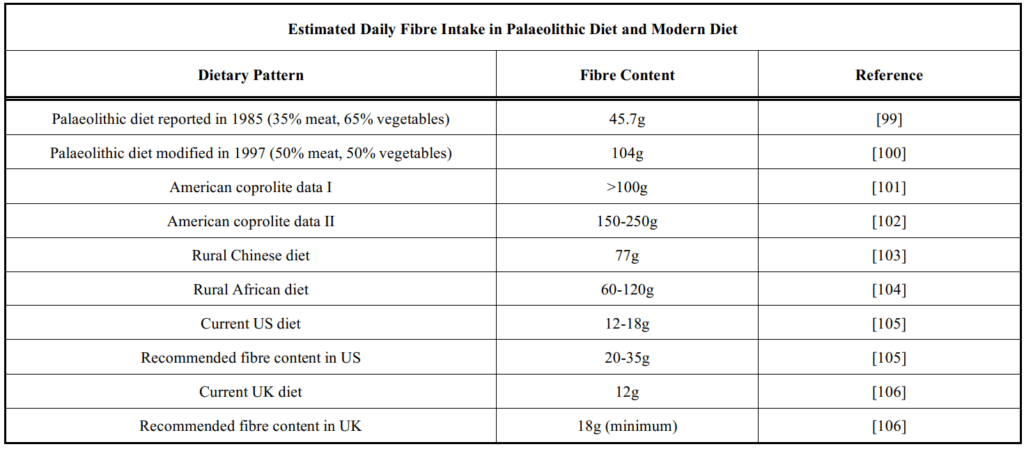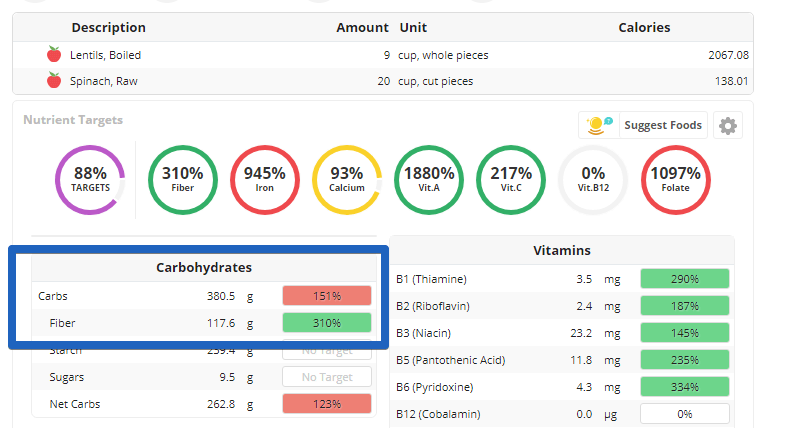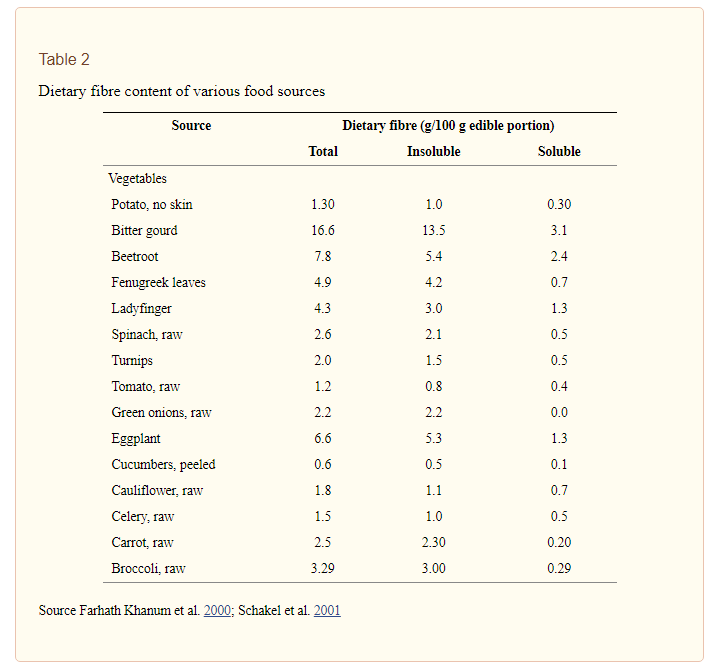Fiber (Fibre) is generally a very good thing, it helps regulate your digestion, which affects things like energy levels.
But is it possible to get too much?
If you’re reading this, you’re probably a relatively new vegan who’s having some stomach issues, and getting too much fiber may be the cause of it.
As I’ll shortly go over, it’s very hard to get too much fiber in terms of serious health issues, but only if your gut is used to it. Suddenly increasing your fiber intake significantly can cause stomach issues and even nutrient absorption issues.
At the same time, eating too much fiber will very rarely escalate to a serious health issue. So don’t panic, just read this article and you’ll have a good grasp on the situation.
Table of Contents
How Much Fiber Should You Eat Per Day?
Among Western countries, most countries recommend getting a minimum of around 25 grams of fiber a day for women, and 38 grams for men.
Here’s an interesting table from a meta-study that examined how much fiber different cultures get in their diet.
In case you’re confused, “coprolite” is fossilized feces, so it’s referring to Americans in the past in that table.
A few things stand out:
-
- Americans and U.K. citizens average a low amount of fiber – Only 12 grams per day for the UK, and 12-18 grams for the U.S. The average person in either county doesn’t come close to meeting the minimum recommended value.
- Rural people in China and Africa get 60+ grams per day, up to 120 grams.
- In the past, Americans, and even some Paleolithic people consumed over 100 grams of fiber a day.
Let’s put this in perspective.
I’m an average sized guy, around 6’0 and 170 lbs, who needs just over 2000 calories per day.
Imagine I ate nothing but lentils and spinach, 2 vegan foods that are high in fiber.
If I plug in 20 cups of spinach, and 9 cups of lentils into Cronometer, which is a crazy amount for one day, that gives me about 2200 calories and 117.6 grams of fiber.
This is right in line with what rural people and older cultures ate on average. As far as we know, they suffered no health consequences from having that level of fiber.
But most vegans don’t get anywhere close to that, unless you’re eating an incredible amount of high-fiber vegetables.
For reference, I get about 90 grams of fiber per day, eating a good amount of legumes, fruits, and vegetables.
If you’re now eating a similar amount on a vegan diet, it may be a big step up if you were starting from the low amount of fiber an average omnivorous diet has in it.
It is very unlikely that you’re getting an unhealthy amount of fiber. It’s more likely that you recently started eating a lot more fiber, and your gut just hasn’t adapted to be able to process it effectively yet.
Signs That You’re Getting Too Much Fiber (Or Haven’t Adapted Yet)
The most common signs of a sudden increase of fiber are:
- Stomach issues – Gas, bloating, constipation, and sometimes diarrhea.
- Decrease in appetite
- Inability to eat enough
The fact that fiber stays in your system for a long time explains most of these issues. Additionally, the stomach issues are typically exacerbated in people with irritable bowel syndrome (IBS).
The type of fiber you’re mainly eating can also make a difference. There are 2 types of fiber:
- Soluble – found in vegetables, fruits, and oats mainly.
- Insoluble – Mainly found in legumes (beans, peas, etc.), seeds, root vegetables, wheat bran (so whole wheat products)
Soluble fiber dissolves in water, so assuming you’re hydrated, it typically ferments easier.
Insoluble fiber is typically harder to ferment and can take longer to adjust to.
Soluble vs. Insoluble Fiber in Vegetables
Here’s a table from a review study that breaks down how much fiber is in 100 grams of a variety of vegetables:
Overall, bitter gourd and beetroot had the most fiber by a substantial amount. Some foods are high in both types, eggplant can cause gas because of this as an example.
But as you can see, pretty much all vegetables have at least a few grams of fiber per 100 grams (which is typically much less than a serving size).
For reference, the daily recommended intake is a minimum of 25 grams for women, and 38 grams for men. There’s not really a such thing as too much fiber, even on a vegan diet.
As far as the difference between soluble and insoluble fiber:
- Soluble fiber – This is what most fiber supplements are composed of. Soluble fiber is absorbed by water in your body and adds “bulk” to your stool.
- Insoluble fiber – Passes through us whole, which can help with regularity.
It’s good to get both in your diet, and just about all foods with high amounts of fiber have more insoluble fiber than soluble fiber, as all vegetables do in that table above.
What to Do If You Suspect You’re Getting Too Much Fiber
Combining everything above, and common sense, there’s a few things you can choose to do now:
- Eat less fiber – Whether by switching out foods for alternatives with less fiber (e.g. white bread for whole wheat bread, or quick oats for steel cut oats), or just eating less in general for a bit.
- Drink more water – Especially if you’re eating lots of soluble fiber.
- Eat different fiber types – Focus your diet more on soluble fiber if you’ve been having issues with insoluble fiber.
- Add enzymes to your foods – These are capsules you can eat with meals that will essentially digest the fiber for you to make it easier on your gut. You can find plenty of affordable options on Amazon.
- Wait – As long as it’s just a bit of discomfort, it will pass after a few weeks (usually) as your gut gets used to handling the higher amount of fiber.
I’m sorry there’s no immediate solution, and they certainly aren’t exciting solutions, but that’s the reality of the situation.
It’s hard to get so much fiber that it’s a major health concern, but you can experience stomach problems while adjusting to a higher level of fiber, which is common when switching to a vegan diet.
If you suddenly have a lot of discomfort or pain after being comfortable on a vegan diet for awhile, it may not be the fiber causing the problems and you should see a doctor.




Thank you for this write up. It seems like a lot of the recent Ex-Vegans on YouTube struggled with digestive issues near the end. Supposedly due to too much fiber.
No problem Janet, I agree that it’s a very common problem, it’s too bad they couldn’t push through or find a way to make a vegan diet work.
Hi, I´ve been vegan for 8 years and I always have at least 6 bowel movements per day. For me, that was always the greattest down side of the vegan diet. And even calculating and reducing my fiber intake and seeing that usually goes around 30-40 g per day, it doesn ´t to make any changes. Don´t get my wrong, I have excellent health thanks to the diet, but it would be nice to have half the bowel movements. I don’t know… maybe I should try to reduce even more the fiber intake and see what happens.
And for so many vegans, this seems to be a big issue. They end up adding fish and eggs to the diet thinking that its making some sort of magic in the body, but I believe that they are simply reducing the fiber intake by making this two foods. Therefore, feeling better.
What do you think about all this, any suggestions?
Thank you
I’ve never heard of 6 times per day (are they really small?). I eat more fiber than that, and I have maybe 1-2 movements on average.
Maybe it’s not an issue of fiber, but eating certain foods that you’re sensitive too? You could experiment with removing/adding certain foods and see if that makes a difference.
Besides that, see your doctor if you haven’t, 6 times a day does not seem normal based on all the vegans I know.
great post! this is super helpful, I’ve been vegan for a few years now but am slowing switching to raw veganism and was wondering if i was getting too much fiber. Thanks so much for this! ?
I have been a vegan for 9 years. I became whole food plant based about 4 years ago. I eat about 60-80 grams of fiber a day per Cronometer. At night- especially lately – I can’t sleep due to stomach discomfort and then I have to drink a lot of water to get to sleep and the process is wearing me out. I want to stay on my whole food plant based diet but I don’t know what to do. I may try the enzyme idea. I also chew a lot of sugarless gum lately and not sure if that’s a factor.
Hi Val, I doubt the fiber is the issue to be honest.
The gum very well could be. Most sugarless gum contains a sugar alcohol (e.g. xylitol, sorbitol), and these are known to cause stomach issues and even diarrhea if you consume too much. Try a few days without any gum and see how it goes.